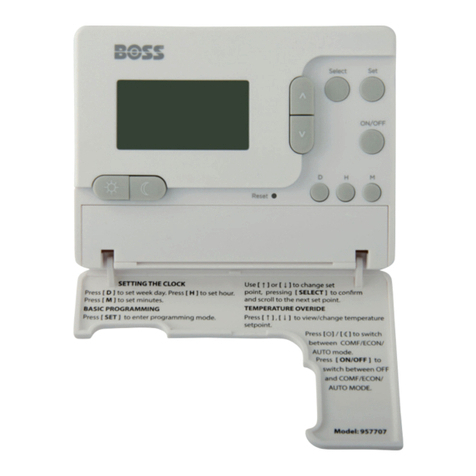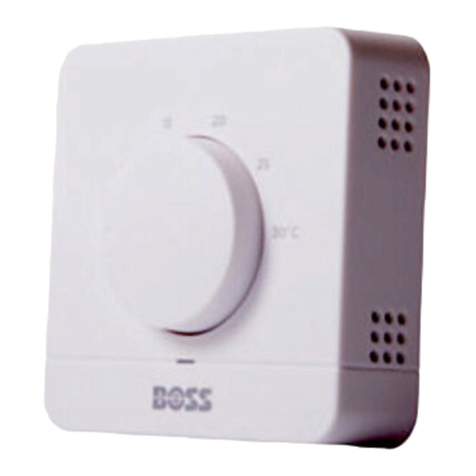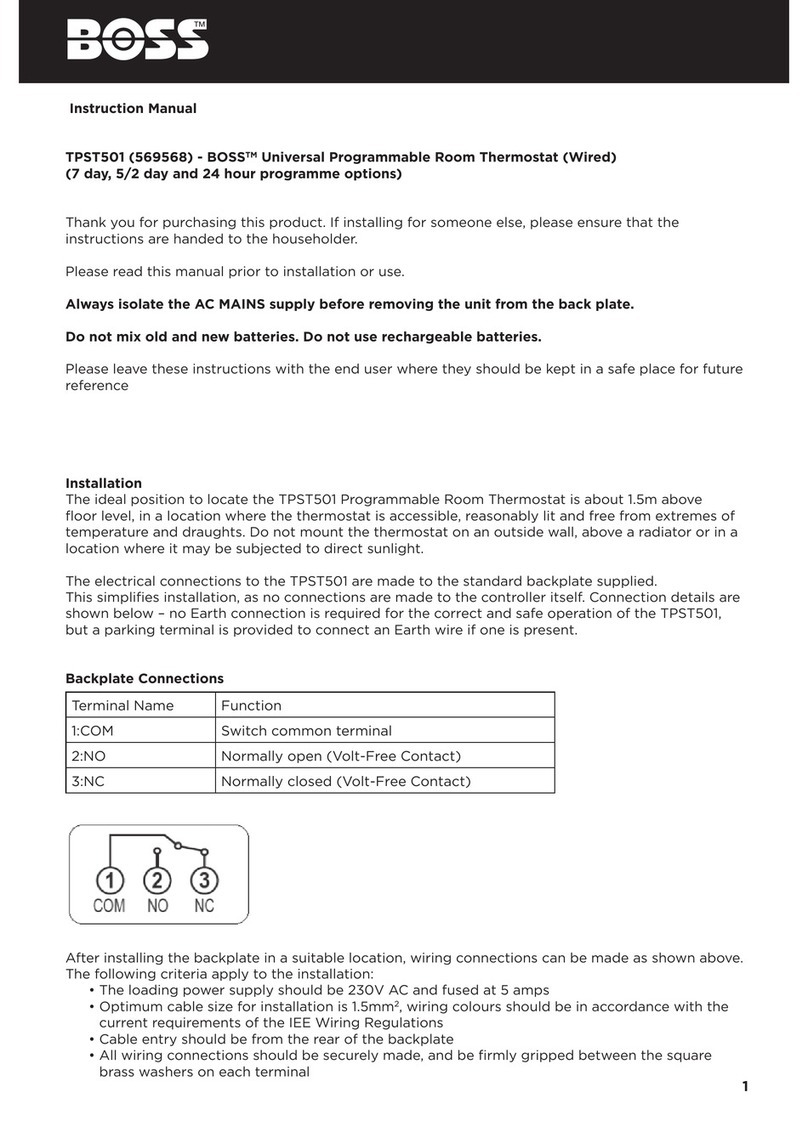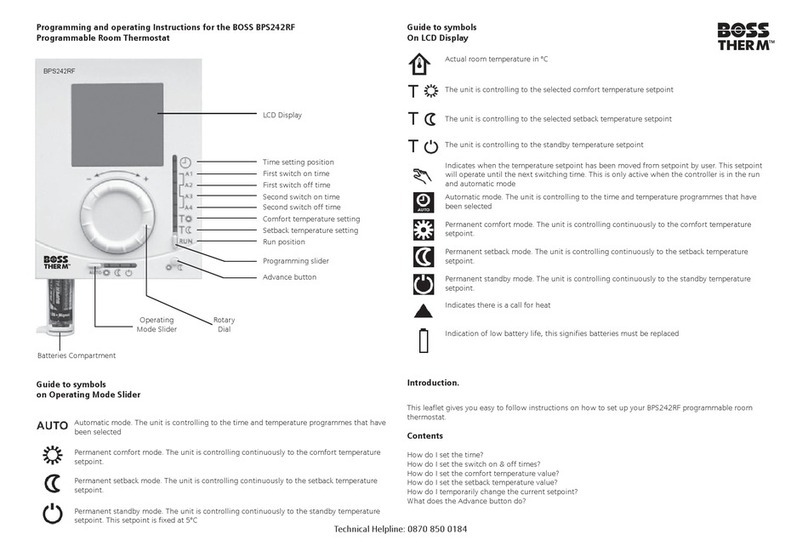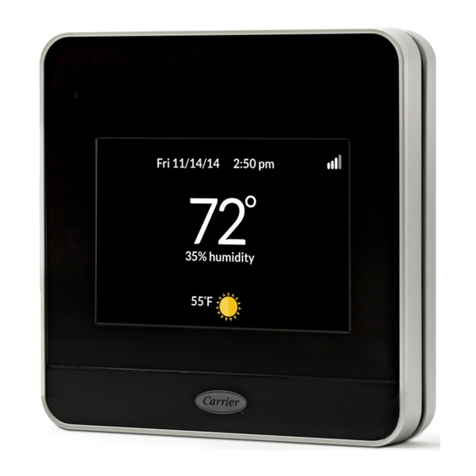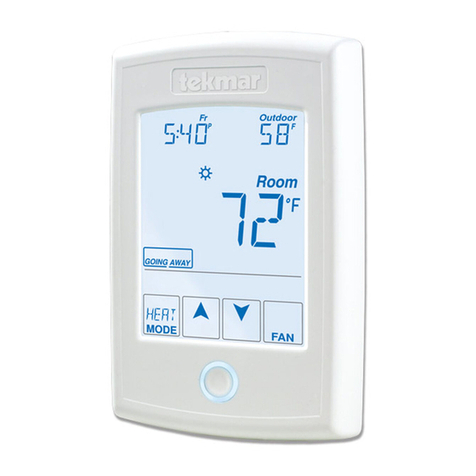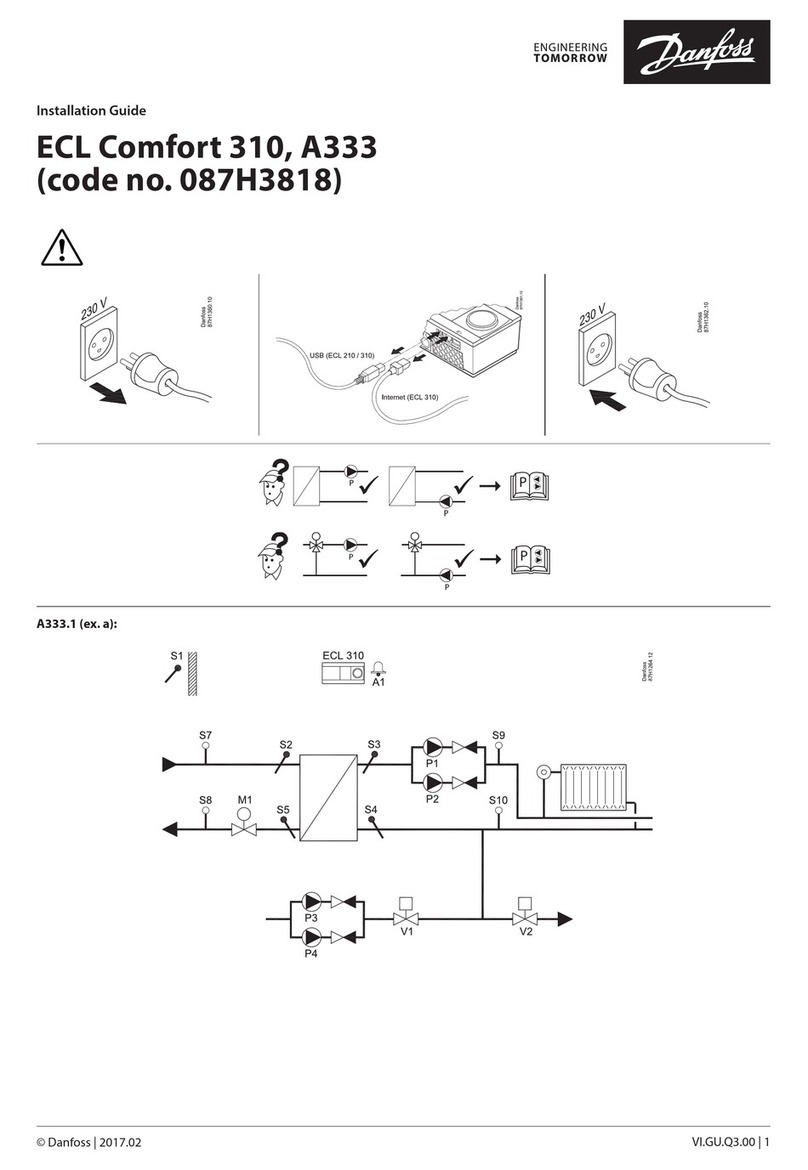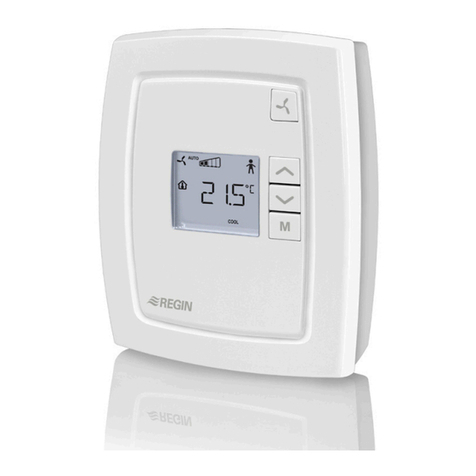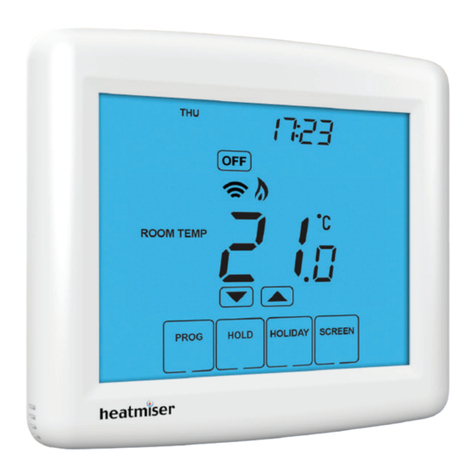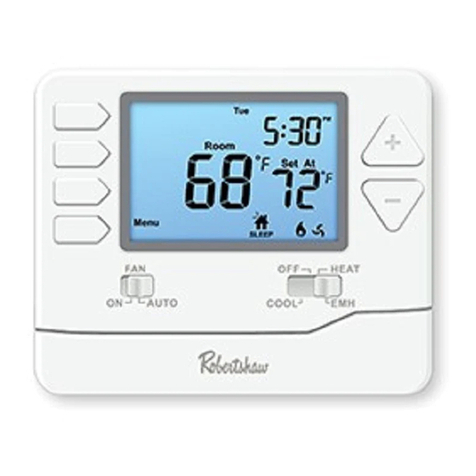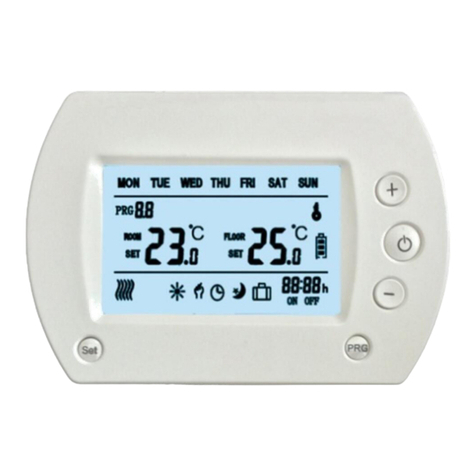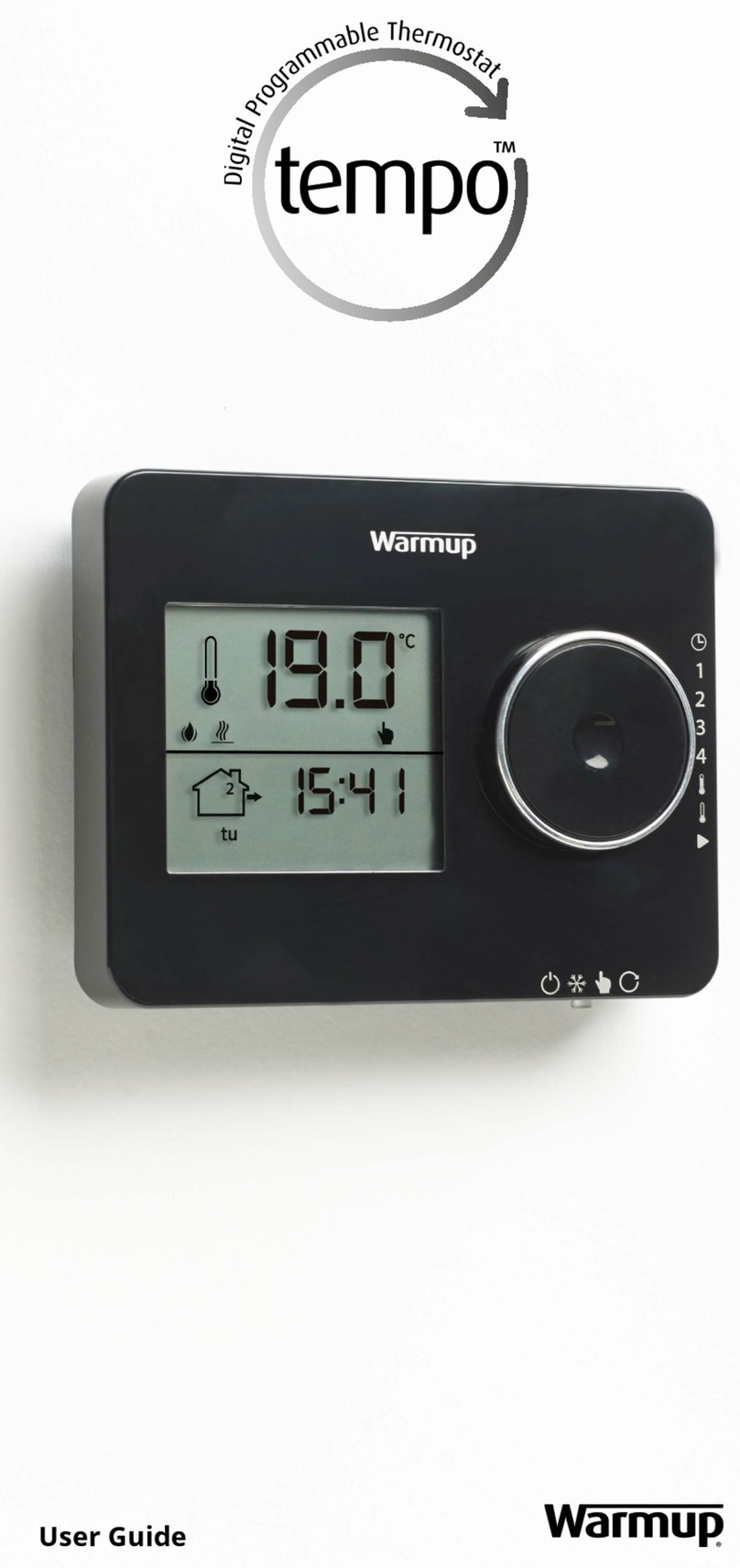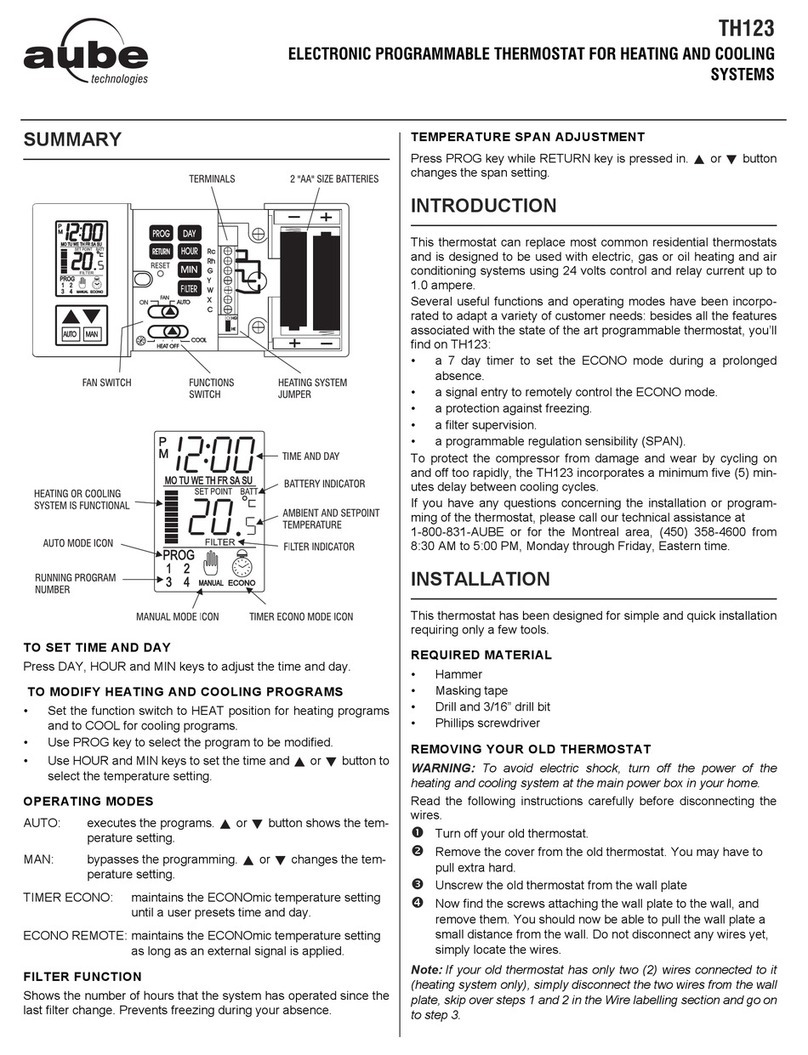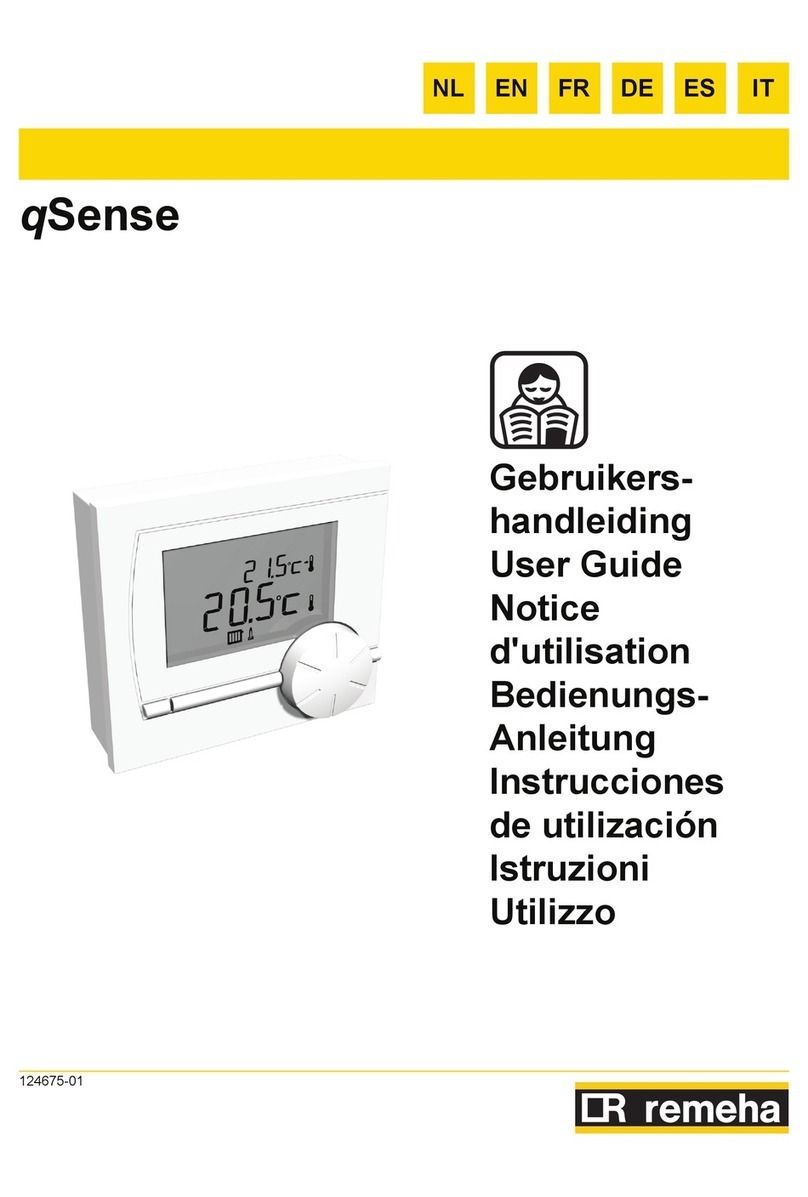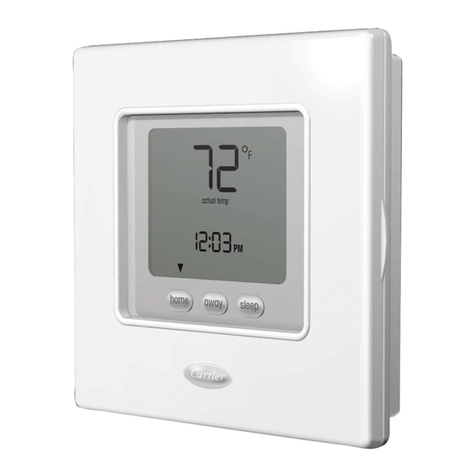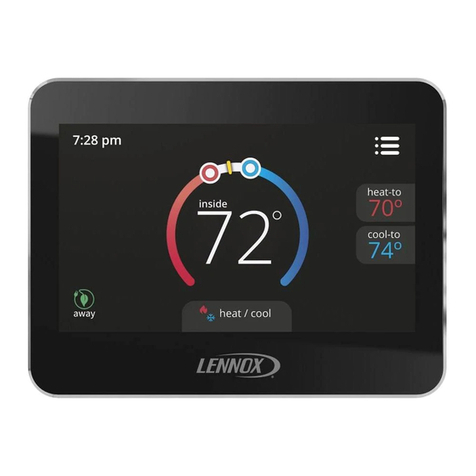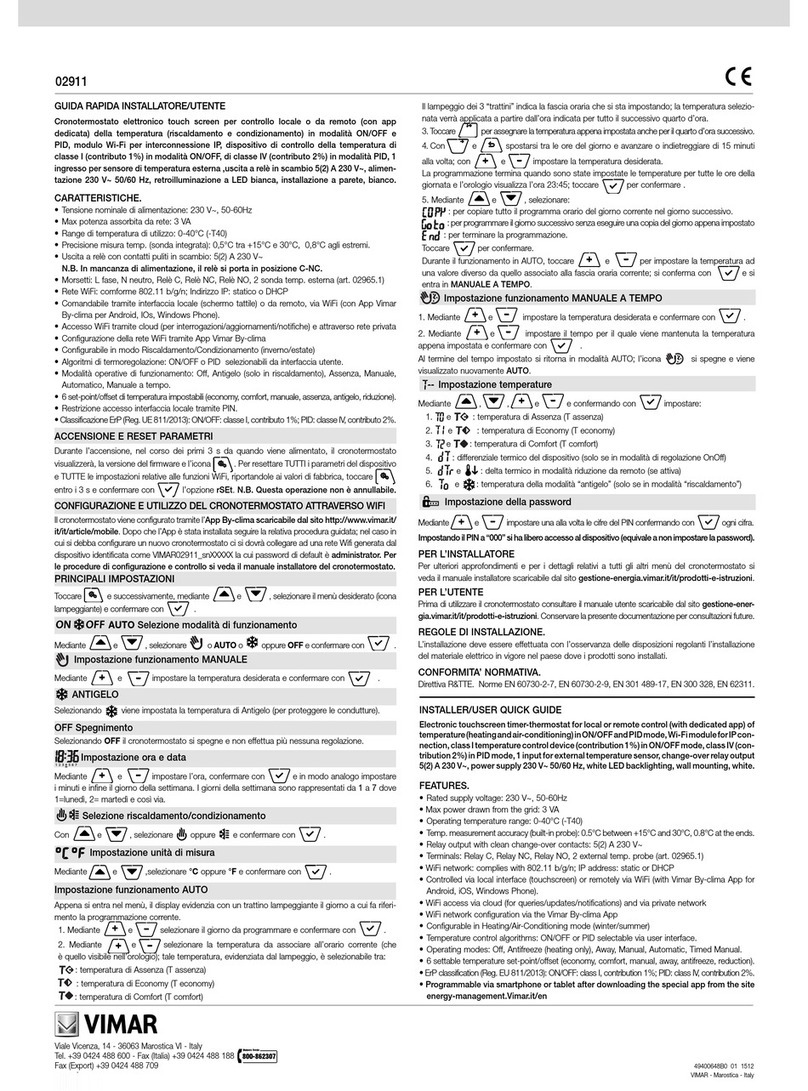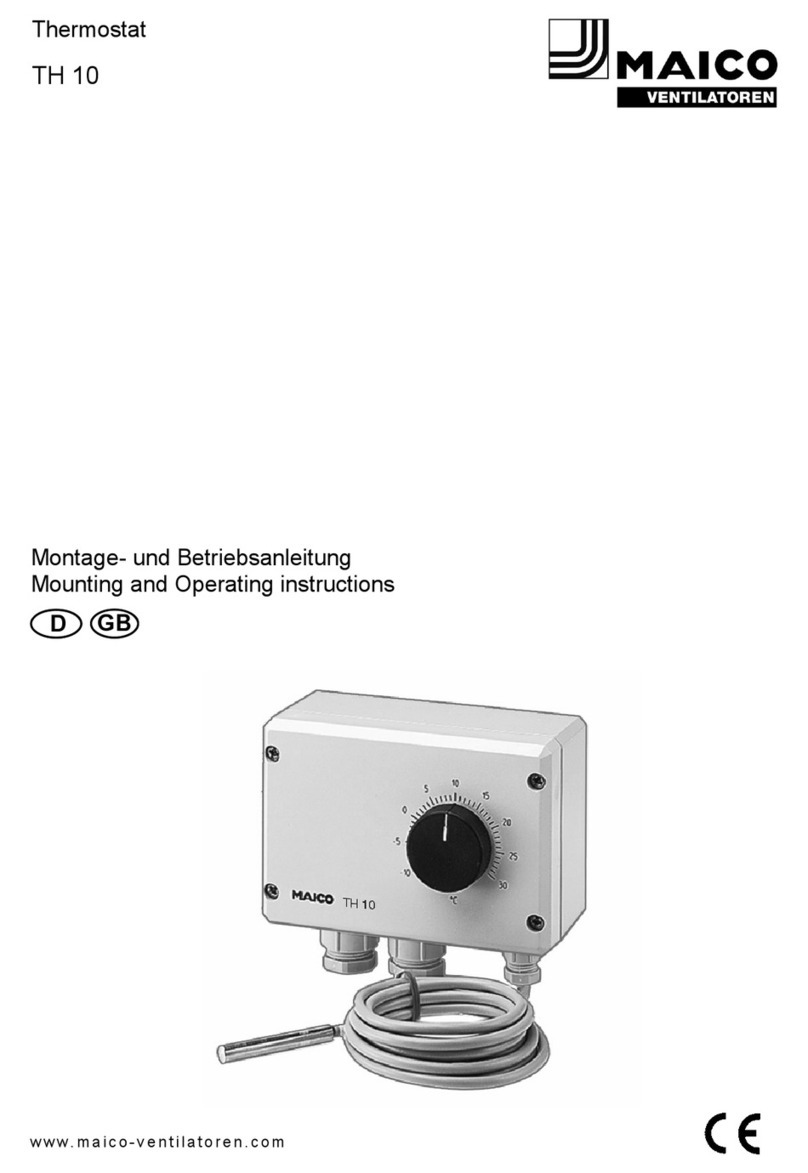BOSSCO TPSRF31 User manual

1
Instruction Manual
TPSRF31 (181430) - BOSSTM Electronic RF Roomstat
Thank you for purchasing this product. If installing for someone else, please ensure that the
instructions are handed to the householder.
Please read this manual prior to installation or use.
Always isolate the mains power supply before removing the unit from the backplate.
Do not mix old and new batteries. Do not use rechargeable batteries.
Please leave these instructions with the end user where they should be kept in a safe place for
future reference.
Installation
The TPSRF31 Control Unit is easily installed using the backplate supplied. This is used purely for
mounting, as no wiring is needed for the Control Unit. The backplate can be mounted directly to
the wall without a back box.
The ideal position to locate the TPSRF31 Control Unit is about 1.5m above floor level. It should be
mounted in a location where the thermostat is accessible, reasonably lit and free from extremes of
temperature and draughts. Do not mount the thermostat on an outside wall, above a radiator or in
a location where it may be subjected to direct sunlight.
To ensure trouble free receiving of the Radio Frequency (RF) signal, always ensure that the
thermostat is mounted away from any possible sources of interference (such as radio, TV sets,
computer, etc.), the location of TPSRF31 in enclosed areas such as cellars and basements is not
recommended, it should be positioned where the temperature sensed is representative of the zone
being controlled.
Connecting the TPSRF31 Receiver
NOTE: All electrical installation work should be carried out by a suitably qualified Electrician or other
competent person.
If you are not sure how to install this digital thermostat consult either with a qualified electrician,
heating engineer or your boiler/heating system supplier for advice on how to proceed.
The TPSRF31 Receiver should be mounted in a suitable location that is both accessible for the
connection of mains and control wiring, and allows good reception of the RF signal. The Receiver
needs a 230V AC mains supply to operate, and this should be fused appropriately (13A max.)
The Receiver should be mounted in a location where it will not come into contact with water,
moisture or condensation.
The Receiver On/Off switch is accessible from the front face of the Receiver.
On the front cover of the Receiver you will see that there is the On/Off switch and two Light
Emitting Diodes (LEDs). The switch allows you to turn off the Receiver if necessary to prevent it
calling for heat. The top LED (orange) will illuminate when the switch is in the “On” position and
the unit is receiving power. The bottom LED (green) illuminates when the Receiver unit is receiving
a heat call transmission from the Control Unit.

2
The wiring terminals and RF Address Code setting DIP switches are located on the rear of the
Receiver.
Receiver Wiring Terminals
Terminal Name Function
N Neutral input 230VAC/50Hz
L Live input 230VAC/50Hz
1: COM Switch common terminal
2: NO Normal open (Volt-Free Contact)
3: NC Normal close (Volt-Free Contact)
Direct Control Boiler
Notes: Receiver unit should have a permanent 230V AC main supply
Combi Boiler
Notes: • Receiver unit should have a permanent 230V AC main supply
• If the boiler has two terminals for the thermostat, remove the link from the boiler
Control Unit Jumper Settings
Changes to the jumper settings should only be made by the Engineer carrying out the installation
or other qualified person.
The installer should select the jumper positions required if changes need to be made to the factory
default settings. These jumpers are found on the rear of the Control Unit.
Jumpers Description
Address code 5 DIP switch levers for 5 bits address code for
RF communication (All jumpers default are closed)
Span
3x1 pins jumper for +/-0.5°C or 1.0°C
(factory default setting) selection.
It is used to define the system to run at +/-0.5°C or 1.0°C
difference to the set temperature
Notes : The Reset button must be pressed after changing jumper positions.
The Reset button is accessible behind the small hinged door on the front right hand side of the Control Unit.
RECEIVER
N.0. COM L N
N
L
BOILER
Live Feed
L N E
MAINS
FEED N L SL
Thermostat (Remove link)
Green/YellowBlue
Brown
Brown
Brown
Brown
Blue
RECEIVER
N.0. COM L N
N
L
BOILER
Live Feed
N E
L N E
MAINS
FEED
YellowBlue
Brown
Brown
Brown
Blue

3
RF Address Code Setting
If there is another unit being used nearby, e.g. in the next house or as part of a multiple installation,
your Receiver may be triggered by the other Control Unit. You can change the RF Address Code to
help to prevent this problem.
Each Receiver can only respond to RF transmissions from a Control Unit that has the same RF
address code setting.
Disconnect the mains power to the Receiver, and remove the batteries from the Control Unit before
attempting any adjustment of the RF Address Code switch and jumpers. If you are not sure how to
carry out this operation correctly, consult either with a qualified electrician or heating engineer.
To adjust the RF address code of the Receiver, simply push up one or more of the 5 DIP switch
levers on the DIP switch bank located on the back of the Receiver, and then make a note of the
setting of each switch. Then set the 5 DIP switch levers on Control Unit same as the RF Receiver
setting so that the address code settings match each other.
For example, if Receiver DIP switches set as following,
Controller unit DIP switch should be set as same:
You must press Reset on the Control Unit after making any changes to the RF address code
settings.
Testing the RF Transmission
It is important to site both the Receiver and Control Unit in locations where the RF signal cannot be
interrupted.
The receiving range between Control Unit and Receiver is approximately 30 meters indoors,
however many factors can affect the RF transmission and shorten the operating distance, e.g.
shielding by thick walls, foil back plasterboard, metal objects such as filing cabinets, general RF
interference, and so on.
The range is generally large enough for most household applications, but it is advisable to test the
RF transmission from the intended Control Unit location to the Receiver location before fixing the
Control Unit to the wall. To check the RF reception, follow the following steps:
1. Press the button on the Control Centre until the set point temperature is higher than room
temperature by a few degrees.
2. Wait for a few seconds. The Burner on (heat call) indicator should appear on the bottom left of
the LCD on the Control Unit.
3. Check the green LED on the receiver unit – it should be lit.
4. Press button to adjust the set point temperature to be lower than room temperature.
5. Wait for a few seconds, and the Burner on (heat call) indicator should disappear and the green
LED should switch off.
6. If at step 3 the green LED is not illuminated, press the Reset on the Control Unit and try to place
the Control Unit closer to the Receiver.
7. Repeat steps 1-5.
If you are unable to get a stable RF connection between the Receiver and Control Unit, check that
the Receiver is both switched on and has a mains supply (orange LED lit). If this isn’t the problem
you can also alter the RF address code by following the “RF Address Code Setting” section of this
manual, and should then repeat steps 1 to 5 (note that the Reset button on the Control Unit should
be pressed after altering the address code.)
1 – ON
2 - OFF
3 - OFF
4 - OFF
5 - ON

4
Function of indicator:
Indicator Function
1
Temperature 1. Show the room temperature in the resolution of 0.5°C
2. Show the set temperature in the resolution of 0.5°C.
The preceding “0” of temperature is not needed.
2
Heat indicator
Displayed when heat is turned on.
3
Econ mode indicator
Displayed when the unit is in Econ mode.
4
Anti-Frost mode indicator
Displayed when then unit is in Anti-Frost mode.
5
Low-batt indicator
Displayed when the battery needs replacing.
User Instructions
Keyboard (Control unit):
Key Function
Increase temperature setting
Decrease temperature setting
Comf/Econ/Anti-frost modes
1. Short press: changes unit to Econ mode while in Comf mode
2. Long press for 3 seconds: changes unit to Anti-Frost mode while in Comf mode
3. While unit is in Anti-frost mode, long key press will return thermostat to its previous mode
Reset To reset the thermostat
Initial Power Up:
• After power up or Reset is pressed, the programmer is reset.
• During system reset, all LCD segments are turned on for 2 seconds or until any key is held.
After 2 seconds and all keys are released, the programmer is initialized. The typical reset display
is shown below.
Following table is the setting of the thermostat after reset or power up.
Default Operation Mode Setpoint
Mode Default Setpoint
Comf mode 24°C
Econ mode 10°C
Anti-Frost mode 5°C
Remark:

5
1) Anti-Frost mode is set at 5°C and cannot be changed.
2) Default is Comf mode after reset or power up.
View/Change set temperature mode
• When the thermostat is in home screen in Comfort/Economy/Anti-Frost mode, press or to
enter View/Change the set temperature.
• The LCD will show the current temperature setting with flashing digits.
• Press or again to increase or decrease the set temperature in 0.5°C steps.
• Press and Hold or for 2 seconds to advance quickly in is 1.0°C steps.
• In Comfort/Economy mode, the temperature can be set between 5°C and 30°C. In Anti-Frost
mode, the temperature is set at 5°C and cannot be changed.
• When changing temperature, only or have functionality.
• If no further keys are pressed, after 5 seconds, the setting is saved and the thermostat will return
to home screen automatically.
Change Operation Mode
The thermostat can operate in three different modes: Comf, Econ or Anti-Frost. The default mode
is Comf.
Change between Comf/Econ/Anti-frost mode
• Short press: changes unit from normal mode to Econ mode, or from Econ mode to normal mode.
• Long press for 3 seconds: changes unit to Anti-Frost mode from any other.
• While unit is in Anti-frost mode, a long press will return the thermostat to its previous mode
Anti-Frost Mode
To enable the anti-frost mode, press and hold the button for 3 seconds. Once Anti-Frost mode
is enabled, the temperature is automatically set to 5°C to provide protection from the risk of
freezing.
Whenever Anti-Frost mode is activated, the Anti-Frost indicator will be shown below.
To turn off anti-frost mode, press and hold the button for 3 seconds.
Please be aware that the Anti-Frost mode operates as an additional protection feature but should
not be used in place of a correctly installed frost thermostat, which is required to override all the
other controls in the system.
The backlight will remain illuminated for approximately 5 seconds.
Backlight
The backlight of the TPSRF31 is switched on automatically whenever any of the keys are pressed.
The backlight will remain illuminated for approximately 5 seconds after the last key press, except
if you are changing the set point temperature – in this case, the backlight will remain illuminated
throughout the setting change process.
The backlight will not illuminate if the TPSRF31 battery is low.
Battery Status
• The TPSRF31 checks the battery voltage frequently during normal operation. If the battery
voltage is sensed as being low (this is normally when the battery voltage falls to a level of below
2.4V, the low battery indicator will be displayed steadily on screen.
• Although the programmable thermostat will continue to operate normally at this stage, you
should replace the batteries as soon as possible to prevent any possible operating problems.
Battery Cut-off Handling

6
• If the battery reaches cut-off voltage (2.1V), the thermostat should turn off its LCD.
• After battery cut-off occurs, the thermostat will stay in cut-off state until new batteries have
been fitted.
Reset Button
The Reset Button is provided to restore the thermostat to its default factory settings. Pressing
this button will delete any previously entered settings.
Temperature measurement
• Temperature below 10°C is displayed without the preceding “0”
• Temperatures outside the controllable range (0.0°C - 35°C) will be indicated by “HI” or “LO”.
Specification
Model TPSRF31
Type Digital thermostat, designed for Volt Free and AC heating applications
Frequency 868MHz
Temperature Scale °C
Temperature Display Range
0.0°C - 35°C;
Displays ‘HI’ if room temperature exceeds 35°C
Displays ‘Lo’ if room temperature below 0.0°C
Temperature Display Resolution 0.5°C
Temperature Setting Range 5.0°C - 30.0°C (0.5°C step)
Temperature Setting Resolution 0.5°C
Operating Temperature 0°C - 40°C
Storage Temperature -20°C - 60°C
Anti-Frost Protection 5.0°C
Power Source
- Control Unit
- Receiver
LR6 AA alkaline battery, 1.5Vx2pcs (do not use rechargeable batteries)
230V AC / 50Hz
BOSS™ is a registered trademark of the Travis Perkins Group
Registered Office: Travis Perkins plc, Lodge Way House, Lodge Way, Harlestone Road,
Northampton. NN5 7UG
Table of contents
Other BOSSCO Thermostat manuals
